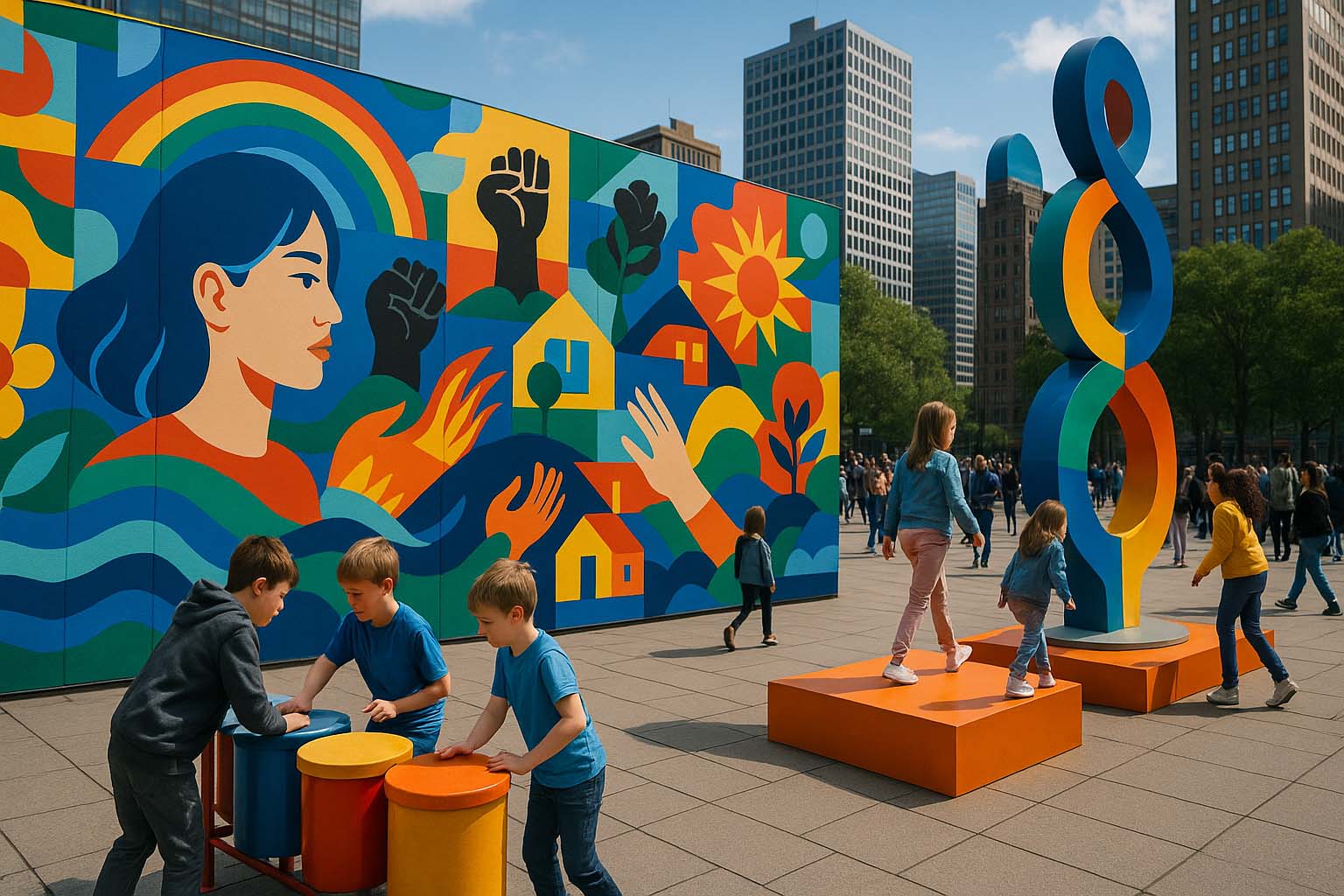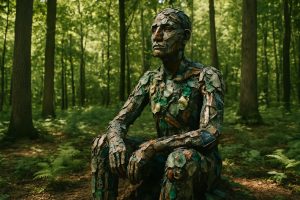
Wider Support from Local Governments for Public Art
Many cities around the world now see public art as more than just street decoration. It’s becoming a powerful tool to strengthen identity, improve economies, and build deeper community connections. Because of this, more local governments are allocating resources and attention to open-space art projects.
Quick Highlights
Budgets for public art have increased in cities like New York, Barcelona, Melbourne, and Seoul.
Street art brings in tourism, strengthens business, and builds stronger local ties.
Clear policies and open processes allow independent artists and small organizations to participate.
Despite maintenance and funding challenges, councils are committed to long-term collaboration with the arts sector.
Funding Growth for Public Art
Over the past decade, many cities have taken more proactive steps to fund public art. A popular method is the “percent-for-art” scheme, where a small part of the cost of infrastructure projects is dedicated to surrounding art installations. London uses this approach to generate millions annually for sculptures and murals.
In the U.S., while national grants from the National Endowment for the Arts still exist, many local governments find that direct funding yields faster and more effective results. In Seattle, a fixed portion of the capital improvement budget is reserved for art, and the city’s arts office streamlines the process for artists by removing complicated application layers.
Establishing Clear Policies
Local governments are not just approving budgets. They’re also setting up clear guidelines—from proposal calls to installation and maintenance. Copenhagen, for instance, has an arts committee composed of representatives from city planning, real estate, and the artist community.
This cross-department setup ensures better coordination and fairness in artist selection. Transparent policies open doors for young and independent creators who might not otherwise access major commissions.
Case Studies Around the World
Melbourne’s “Public Art Melbourne Biennial Lab” brought together international artists and local communities to co-create site-specific works. The initiative received backing from the city council, art foundations, and private sponsors.
In Bogotá, the “Grafiti para Todos” program changed how people view street art. Through legal wall spaces and mentorship, artists were paid for their work and formerly dark alleyways became vibrant public spaces.
Economic and Cultural Impact
Officials often cite public art as a catalyst for local business. Chicago’s “Cloud Gate,” also called “The Bean,” generated billions in tourism revenue. While the city spends on its upkeep, the return through taxes and new jobs makes it worthwhile.
In Medellín, public art plays a key role in the revival of formerly troubled districts. As visitors arrive, new cafés, galleries, and bakeries thrive. Art becomes a city’s signature—something authentic and hard to imitate.
Community Participation and Education
Installing a mural in a plaza is not enough. Residents need to feel included. Seoul trains “citizen curators” who explain the meaning of the work to visitors.
This leads to school and senior center programs tied to public art. People talk about art at the dinner table, which builds grassroots support. Arts Council England observed that when community ties are strong, even small businesses step in as donors.
Technology Making Art More Accessible
Technology helps people experience public art even if they can’t visit in person. In Vienna, an augmented reality app shows how a proposed sculpture will look in its future location. This creates more open dialogue and reduces opposition.
In Helsinki, residents can vote online on designs for public benches or heritage markers. This boosts engagement and gives a sense of shared ownership.
Positive Effects Often Linked to Public Art
Creates lasting attractions that boost tourism and local income.
Revitalizes older neighborhoods and attracts new business.
Encourages conversations about history, culture, and identity.
Common Challenges and Solutions
Despite growing support, there are still issues—ongoing maintenance costs, vandalism, and the need to maintain artistic standards. A clear agreement between city planning and arts departments is key.
São Paulo launched an “adopt-a-mural” program. Local businesses cover annual repainting costs to ensure high quality. This protects artistic standards without burdening the city.
Steps Artists Can Take to Get Involved
For independent artists hoping to join public projects, here are common requirements by arts councils:
Prepare a strong portfolio. Choose work that matches the space and vision.
Follow the set theme. If the theme is climate, show a thoughtful approach to that topic.
Provide a clear budget. Local governments appreciate transparency. A detailed cost breakdown speeds up approval.
Aligning with Urban Planning Goals
Artists and curators must consider how their work fits into broader city goals. Toronto includes public art and green spaces in its master plan. This alignment allows architects and artists to collaborate on parks and sculptures.
Shared goals make it easier to gain support from both residents and private investors. Partnerships between transit agencies and arts councils have proven effective in ensuring sustainability.
Eco-Friendly Practices in Public Art
More cities now favor materials and methods that reduce environmental impact. In Vancouver, artists who use recycled metals and low-carbon resin were prioritized. One permanent piece even uses solar power to light up at night.
These practices reflect the city’s commitment to a greener future and help win public support.
Tracking Success with Data
Public art is evaluated not just visually, but with data. Rotterdam uses pedestrian counters and surveys to track increases in foot traffic around installations. This data is shared with the city council to justify future investments.
Sydney measures social effects like drops in vandalism around new murals. Positive results make these projects templates for other districts.
Strengthening Community Bonds
Success also shows in personal stories. In Berlin, residents bring old neighborhood photos to inspire mural artists. Elders share their stories, and a stronger respect for local heritage is born.
Montreal’s “MURAL Festival” sparked neighbor-to-neighbor connections, not just artist-to-audience engagement.
Forward-Looking Approaches
Digital tools are reshaping city-art relationships. Tokyo is testing a kinetic wall that lights up and moves in sync with passing pedestrians. The goal is to turn this into a feature in future transit hubs.
City planners and engineers are assessing its potential as part of a modern public space experience.
Private Sector Support
While most funding still comes from local governments, private investment is growing. In Doha, an energy company funded an LED installation along the coast. The city’s arts office curated and monitored the project.
Such partnerships work well when clear guidelines are in place. The business gains a positive public image while supporting culture.
Respecting Local Culture
Every community is unique. Reykjavík allowed artists to use old fishing gear in their sculptures, honoring the city’s maritime history. This not only drew visitors but also stirred national pride.
When art reflects a place’s true heritage, people connect with it on a deeper level. Public art then becomes a story, not just a style.
The Role of Transparency
Public trust increases when spending is transparent. Amsterdam’s arts council posts detailed project info online—artist names, artwork sizes, and total costs.
This openness shortens approval times and builds trust. When people know the process, they are more likely to support the next project.
Raising Young Talent
Cape Town introduced an “Emerging Creatives Incubator.” Young graduates receive grants, studio space, and mentorship. In return, they install public pieces and lead workshops at local schools.
This system ensures new ideas replace outdated ones, building a pipeline of talent for the future.
Communicating the Story Behind the Art
Effective storytelling drives engagement. Barcelona runs a documentary series explaining how public mosaics were made. These videos show the link between artists, funders, and the community.
According to UNESCO data, public art sites get 20% more visitors when the creation process is shown online.
Adapting During Crises
During the 2020 lockdowns, galleries closed. Cities turned to outdoor displays. In Singapore, sculptures were moved outside with QR codes providing contactless info.
This model was praised for delivering culture safely, proving public art’s resilience in tough times.
Blending Art with Nature
Artists are teaming up with environmental scientists. Oslo’s floating art piece made of plastic bottles slowly melts to show pollution’s effects.
Supported by the city’s climate plan, it educates and inspires change at the same time.
Designing for Everyone
Inclusive design matters. In San Francisco, a mural includes a tactile version and audio description for those with visual impairments. This aligns with the city’s accessibility goals.
Such efforts prove that public art can serve everyone, not just those who can see or hear it.
How Citizens Can Join In
There are many ways to contribute—send feedback to city offices, attend hearings, or join community painting events. Even sharing photos online helps grow awareness.
In Munich, transit users were surveyed by phone about what art they want in the new station. Even quick input shaped the final decision.
Training and Education
Seoul National University and the University of the Arts London launched courses in public art management. These programs help professionals learn procurement, conservation, and outreach.
With more trained experts, cities avoid mistakes and handle legal and cultural aspects more effectively.
Aligning with Smart Urban Systems
Some cities include public art in smart infrastructure. In Dubai, a kinetic piece changes color based on nearby building energy use. It encourages viewers to reflect on environmental habits.
It proves that science, design, and creativity can deliver meaningful public messages.
Keeping Art Relevant Over Time
Long-term planning is critical. The UK’s Local Government Association suggests reviewing installations every five years. This helps decide whether to update, move, or retire artwork.
By refreshing policies regularly, cities ensure public art remains timely and meaningful.
Ongoing Encouragement
Local governments continue expanding their support because they clearly see the value. Public art boosts business, brings communities closer, and fills streets with meaning. With teamwork among officials, artists, and residents, cities are lighting up with creativity for all to enjoy.

